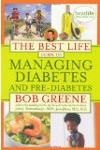Here's a good progression for both beginners and experienced exercisers to follow during strength training:
- Begin with 1 or 2 sets per exercise, 8 to 10 repetitions per set, at
least two times a week. Take no more than 20 to 30 seconds in
between sets. You may find you can't make 8 to 10 reps in the
second set, but that's okay; it's evidence you're working hard
enough in the first set to produce changes in your muscles. As
your strength improves, you'll eventually make the reps. - After about four weeks, reassess. If you're making all your sets
easily, add another. Also check your weights. Are they heavy
enough? - Keep reassessing every four to six weeks, and when you're ready for
a new challenge, add another day. Your ultimate goal: 3 sets of
each exercise, 8 to 10 reps, every other day.

More About this Book
The Best Life Guide to Managing Diabetes and Pre-Diabetes
Strength training guidelines include:
1. Start slow and gradually increase the intensity of your workouts. This will help alleviate excessive soreness when you begin a resistance training program and prepare your body for more intense workouts down the road.
2. Never strength train the same body part on consecutive days. Give your muscles at least 24-48 hours rest between workouts.
3. Always maintain proper form and technique. If the weight is too heavy to lift correctly, opt for a lighter weight. You will get better results and greatly reduce your chances of injury.
4. The last few repetitions should be difficult to lift while maintaining proper form. For example, if you chose to perform 12 repetitions then reps 11 and 12 should feel rather heavy. If the weight is easy to lift you’re not adequately challenging your muscles.
5. Ask a certified personal trainer for assistance if you need help learning how to use free weights or strength-training machines.
6. Always re-rack your weights.
7. Certain exercises such as the Bench Press require a spotter.
8. Give yourself plenty of room to perform free weight exercises. Stay clear of obstacles and other patrons.
9. Do not drop the weights.
10. Stop if you feel pain during an exercise.
11. When starting out, perform strength-training workouts twice a week targeting every major muscle group. As your fitness improves the frequency and volume of your workouts can increase.
12. Don’t forget to breathe; avoid holding your breath. This can cause dizziness, fainting, and raise your blood pressure.
Continue Learning about Strength Training & Exercise
Important: This content reflects information from various individuals and organizations and may offer alternative or opposing points of view. It should not be used for medical advice, diagnosis or treatment. As always, you should consult with your healthcare provider about your specific health needs.


